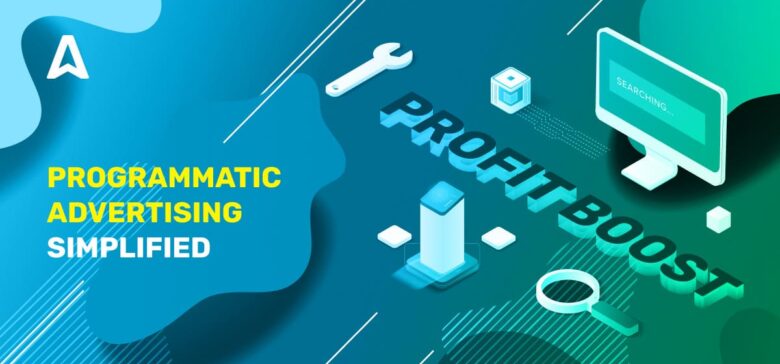Programmatic advertising helps automate the process of buying huge volumes of traffic while also optimizing campaigns in real-time for better performance and efficiency. According to Statista, the global programmatic ads market hit $493 billion in 2022 and is expected to rise to $725 billion in 2026.
But what exactly are programmatic ads? How does it work? How does it lead to better ad-buying outcomes for brands and businesses? This article will explain it and answer these common questions.
What is programmatic advertising?
Programmatic advertising is a type of digital advertising that uses software and algorithms to automate buying, placing, and optimizing ads for effective results. It streamlines and makes things much easier for advertisers and affiliate marketers.
A brief history of display advertising and the Rise of programmatic advertising
The first display ad on the internet appeared in 1994; AT&T, an American telecoms company, purchased a three-month ad slot on the online magazine HotWired. In 1995, display ads gained popularity, and companies began targeting specific demographics instead of placing them in random spots. Ad networks emerged to connect companies with websites selling ad slots. DoubleClick, founded in 1995, is regarded as the first advertising network.
Ad networks prepared the entry for programmatic advertisements. In the 2000s, ad networks began offering real-time bidding (RTB) technology, which enabled advertisers to purchase ad slots in real-time. Over time, this technology has improved and led to the rise of programmatic ads.
You can bid for high-quality ad slots in real-time on Adsterra and pay per thousand impressions. Our network gives you access to over 28,000 publishers serving 32+ billion monthly ad impressions.
Types of programmatic advertising deals
Real-time bidding (RTB)
In RTB, advertisers bid for ad inventory in real time through an auction process. Every advertiser sets their price, and the slot is given to the highest bidder.
The entire auctioning process happens instantaneously, and advertisers can choose from different ad slots as soon as they become available. Once they win the slot, their ad is shown on the website for a specific period.
Private marketplace (PMP)
This is a real-time bidding process where the website publisher opens its inventory only to select buyers. The publisher invites a relatively small number of advertisers to bid for their ad slots. It works the same way as real-time bidding but with few advertisers bidding for the slots. The publisher can set a minimum bid and some other restrictions that the advertisers must adhere to.
Preferred deal
This is an arrangement where a publisher agrees to give a specific advertiser preferential access to their ad slots. In exchange, the advertiser agrees to pay a specific price for the ads. This method is low-risk because the advertiser can negotiate prices beforehand and, in some cases, access the publisher’s analytics dashboard to confirm that their traffic is legitimate.
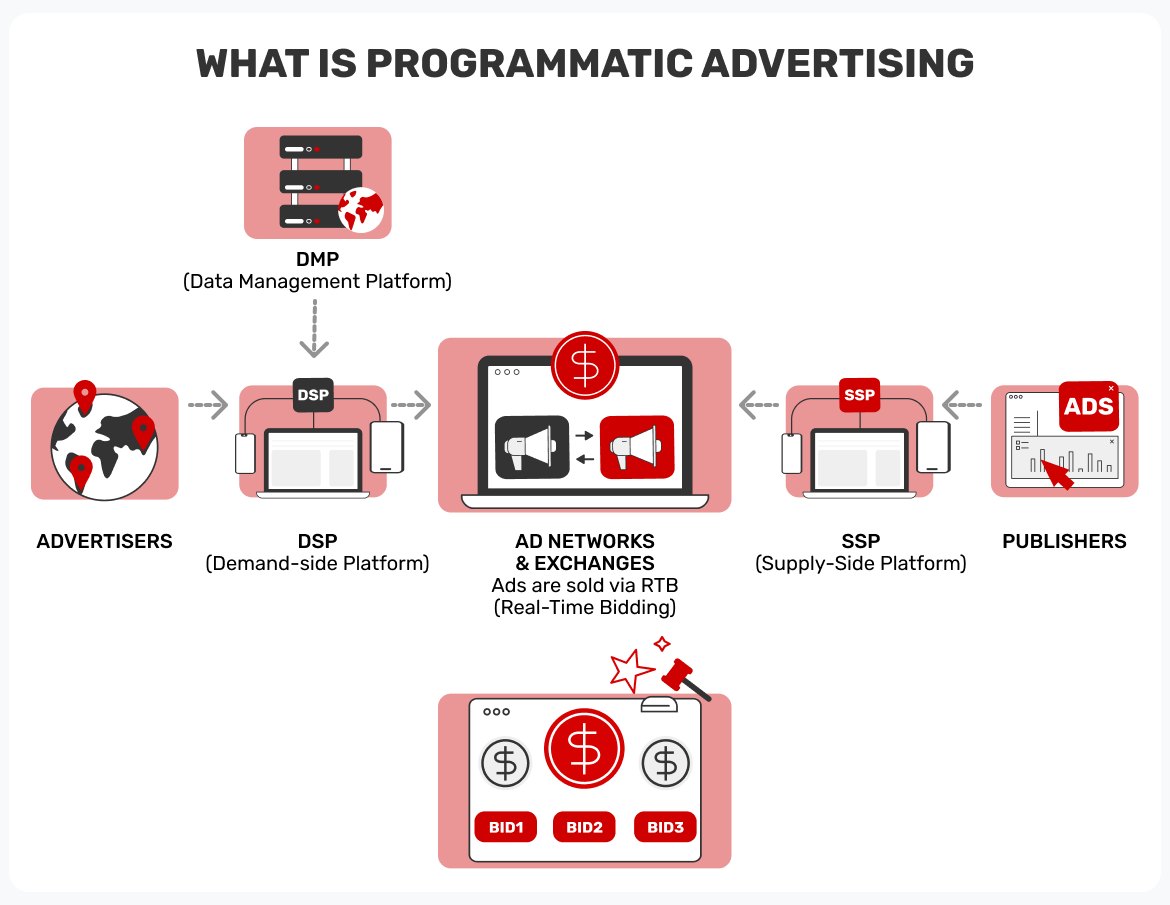
How does programmatic advertising work?
Programmatic ads require robust computing resources to work because everything is automated and happens in real time. Different platforms take care of aggregating the ad inventory, auctioning them, tracking the bidding, and monitoring the results.
The three main parties of programmatic ads are:
Demand-side platforms (DSP)
The demand-side platform is the network where the automated real-time bidding takes place. It can be different types of ads, including Banners, Popunders, Insterstitials, etc. The DSP is the marketplace where the programmatic ad buying takes place. Advertisers can purchase ad slots from multiple sources and monitor the results on their DSPs, and the entire buying process is automated.
Supply-side platforms (SSP)
The supply-side platform is what website publishers use to manage their ad inventory and choose which slots to place for auction. The DSPs aggregate the inventory offered by the SSPs and place them up for advertisers to bid.
SSPs help publishers maximize their revenue by offering slots to as many buyers as possible. They’re also called yield-optimization platforms for this reason.
What is the difference between an SSP and a DSP
The demand-side platform serves advertisers, while the supply-side platform serves publishers. The DSP helps advertisers optimize their ad spend for effective results, while the SSPs help publishers maximize their revenue from the ad buyers.
In the programmatic ads marketplace, SSPs are the sellers and DSPs are the buyers. They both play important roles in the programmatic ad buying process.
Data management platforms (DMP)
A data management platform monitors what visitors do on a website. It collects, stores, and organizes user data from several sources and shows them to advertisers. The advertisers use this data to determine if a specific ad inventory will give them the desired results. With this data, they can decide which websites are the best to work with and develop effective advertising strategies.
How much does programmatic advertising cost?
Advertisers usually pay for programmatic ads on a cost-per-mille (CPM) basis; mille refers to a thousand impressions. Expect anywhere from $0.50 to $2.00 per mille. This is usually more cost-effective than manual ad buying, where prices can reach up to $10 or more. Thus, programmatic advertisements offer more value for money.
Note that several factors affect the cost of programmatic ads, such as the DSP you choose and the type of websites you target.
6 Steps in programmatic advertising
Step 1: Website Visitors
The process starts with someone visiting a website. The user types the URL in their web browser and clicks on it. Tracking starts immediately when the user visits the website, even though they may not notice.
Step 2: Ad inventory
After the visitor loads the website, the publisher lists the available inventory to show an ad to the visitor. It passes that information to the SSPs, which, in turn, passes it to the DSPs. The process is all automated.
Step 3: Algorithms
The SSP uses algorithms to analyze the visitor’s information, such as demographics, age group, on-site behavior, etc. Afterward, it matches the visitor with an ad relevant to their interests.
Step 4: Estimation
After analyzing the user’s behavior, the SSP estimates the cost of showing an ad to them and passes that information to the DSP.
Step 5: Bidding
Advertisers submit bids to the DSP. The publisher sorts through the bids to select the winner.
Step 6: The ad is shown
After selecting the winning bid, the advertiser’s ad goes to the website’s server to be shown to the visitor. The entire process takes about 250 milliseconds to complete, which is nearly instantaneous.
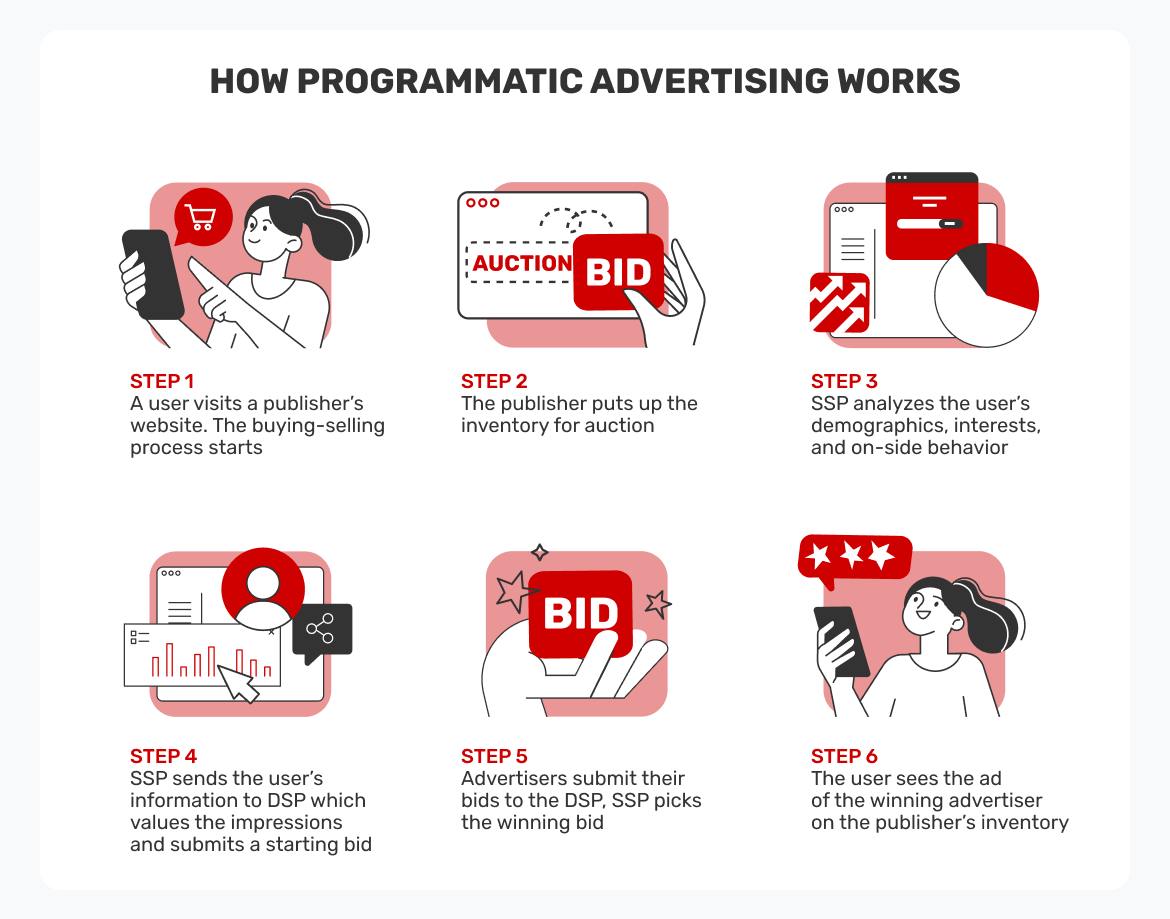
Benefits of programmatic advertising
Programmatic ads offer a lot of benefits. It can yield great results when done right. For instance, it allows publishers to serve their users with relevant ads they’ll likely be interested in. Similarly, it helps advertisers target the right audience and get effective results.
Programmatic ads are very efficient and carry lower risks of ineffective ad spending.
Programmatic advertising benefits for advertisers
- Growth opportunities: Advertisers gain access to a larger ad inventory to spread the word about their brand. They can choose from millions of publishers and deploy different types of ads.
- Flexibility: Advertisers can evaluate and adjust their ads in real-time based on the metrics they get.
- Targeting: Advertisers can target their intended audience more effectively and do more with a lesser budget.
- Relevancy: Users will view your ads at the time when they’re most likely to respond to them. Programmatic ad marketplaces provide many tools to help brands identify the best audience.
- Reporting: Advertisers can monitor the results of their ads in real time and immediately adjust if they spot any issues. They can monitor critical metrics such as bounce rate, click-through rate, brand engagement, etc.
- Lower ad fraud: Advertising fraud is a major problem worldwide. According to Statista, it cost $81 billion in losses to advertisers in 2022. It comes in many forms, such as click farms interacting with ads. The good thing about programmatic ads is that they have lower risks of ad fraud.
Adsterra uses algorithms and advanced security techniques to prevent ad fraud. We track every publisher on our network closely and ensure advertisers get neat traffic.
Benefits of selling ads programmatically for publishers
- Revenue maximization: It connects publishers with as many ad buyers as possible in an auction process. With many advertising bidding for relatively few slots, publishers can maximize their ad revenue.
- Relevant ads: Programmatic ad platforms usually show relevant ads that won’t annoy users.
- Flexibility: Publishers have a lot of flexibility in managing their ad slots. They can choose which slots to sell through auction and offer other slots to pre-determined buyers. They have full control over their slots and can optimize them for maximum revenue.
What are the downsides of programmatic advertising?
- Some agencies take advantage of their client’s lack of technological understanding to overcharge them.
- A lack of visibility into the sites brands place their advertisements on.
- Sometimes, your ad will be matched with irrelevant websites and audiences, giving poorer results.
- Privacy concerns have led to pushback against web browser cookies, which programmatic ads depend on.
- Pricing can be inconsistent and opaque.
Important characteristics to look for in a programmatic ad agency
- Check if they have sufficient human expertise and an appropriate technology stack.
- The team should have prior experience with data analytics and advertising strategy. There should be data scientists and digital marketers among them.
- Ensure pricing is transparent and with no hidden fees. You should be sure your budget is going primarily towards buying advertising space.
- Check reviews to see if previous clients say good things about them. As for their portfolio and case studies.
- Check if they’re helping you reduce cases of advertising fraud in your campaigns.
What are programmatic advertising examples?
Probably we’ve already said enough about programmatic advertising. Now is the time to look at the examples.
1. The Economist
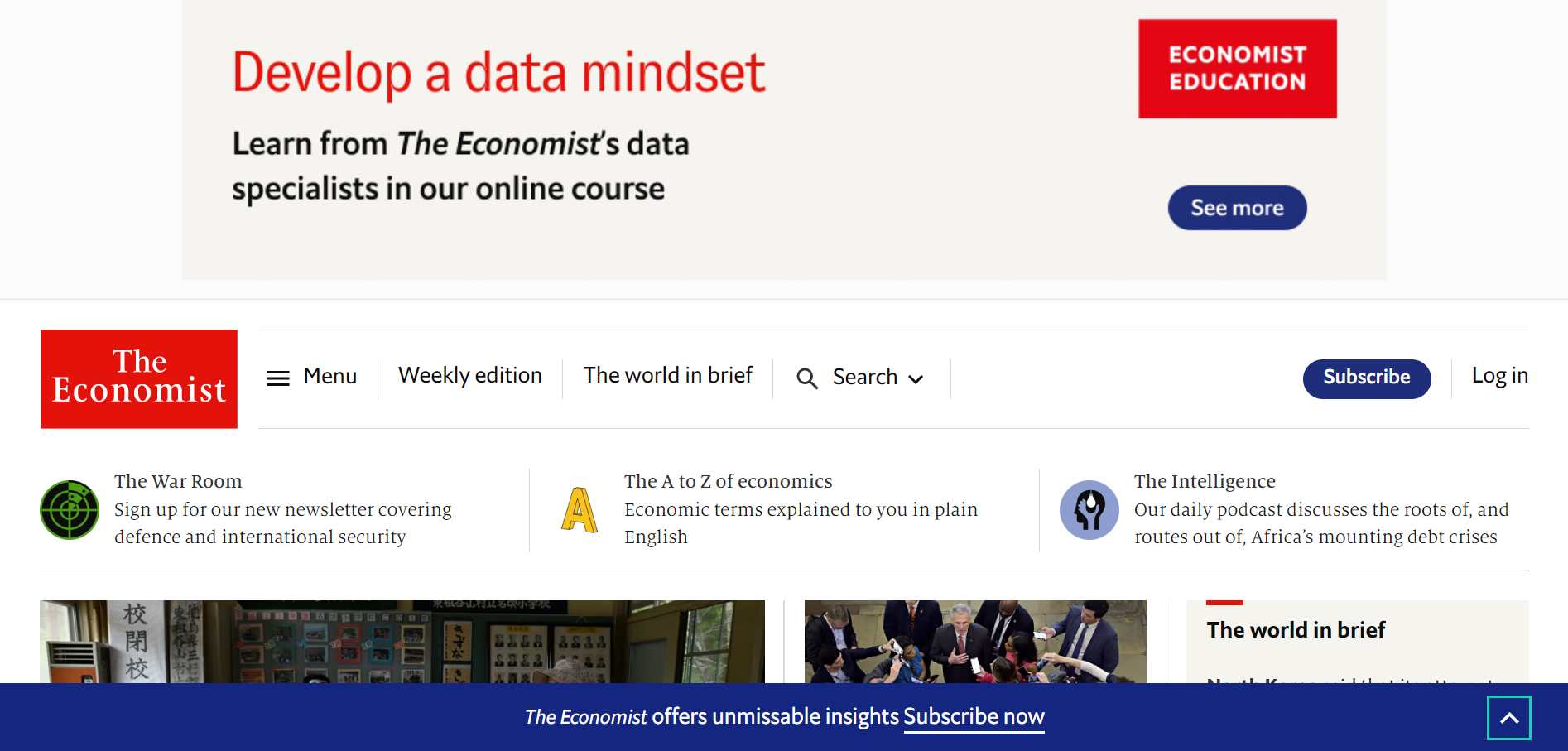
The Economist used programmatic advertising successfully by referencing subscribers, cookies, and content data. Its campaign brought in 650,000 new leads and gave a 10:1 return on investment (ROI).
They tried programmatic advertising to get curious but reluctant readers to give them a try. Since The Economist covers a wide range of topics, from business to technology, the company had to ensure that its ads were relevant to the magazine’s readers.
The publication looked at all the information it had about its readers and included information about how subscribers used the publication’s website and mobile app. The Economist used its data to determine what kind of content readers liked.
After this first analysis, The Economist divided its readers into Finance, Politics, Economics, Careers, Technology, and Social justice. Then they built audiences that looked like these segments.
Ads were made for each of these groups of people based on what they liked. For example, someone interested in technology would see an ad that showed one of the magazine’s most recent (or most popular) technology stories.
Overall, The Economist launched more than 60 different ads, which led to the following:
- 6 million unique actions;
- 1 million unique website viewers;
- 650,000 more possibles;
- $650,000 in ROI from ads;
- The lifetime value of the 9500 new subscribers is $15 million;
- 64% more people in the U.S. are “aware” of the issue;
- 22% more U.S. audiences are “considering”;
- U.S. audiences’ “willingness to recommend” went up by 10%;
- 10:1 campaign ROI.
Source: Shortyawards
What can your company learn from this programmatic ad example?
Use your website and user data to find out more about your audience. With that information, you’ll be able to make ads that speak to your audience and get them to do something.
2. Kellogg’s
In 2014, Kellogg’s started using programmatic advertising to boost store sales. Kellogg’s was able to target their ads 2–3 times better.
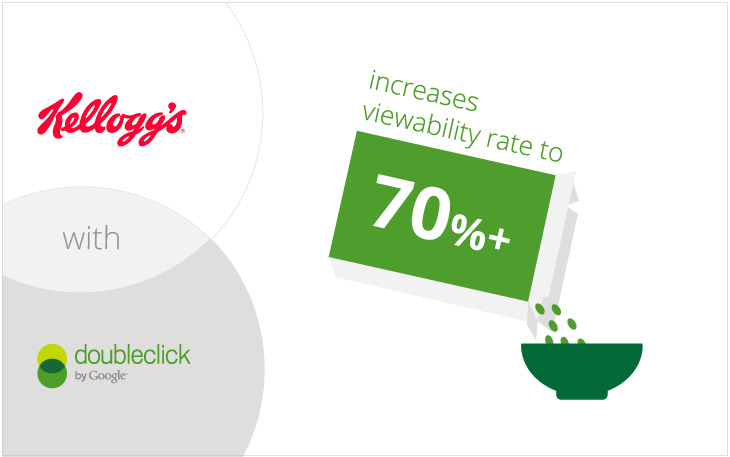
Digital advertising is hard for companies like Kellogg’s that make most of their money from in-person sales. This is why they review KPIs like viewability and frequency. These businesses need to see a link between an online ad and an in-store purchase.
Viewability measures whether a user sees an ad or not. While frequency measures how often a user sees an ad.
Kellogg’s got the most out of these KPIs by using programmatic advertising. They teamed up with an ad management service, to improve its audience targeting and make more effective hyper-targeted ad campaigns.
Results:
- Viewability rates went up by 70%;
- 2X to 3X better at targeting the right people.
Source: Thinkwithgoogle
What can your company learn from Kellogg’s programmatic ad example?
You shouldn’t ignore digital advertising even if you run an offline business. People spend almost 24 hours a week online, which is a lot of time.
3. The Intercontinental Hotel Group (IHG)
IHG started using programmatic ads to compete with third-party booking sites like Trivago. IHG looked into how people book hotels and found that most people use third-party sites because they think they are getting the best deal.

IHG, on the other hand, knew that travelers usually paid 15–30% more when they booked through these sites than when they went straight to the hotel. Their programmatic ads showed users how much it would cost to book directly with hotels like Holiday Inn. IHG also made these ads specific to the user by using the user’s browsing history to pull the hotel location, date, and price.
These ads performed very well because they were clear about how much they would cost. Users knew right away how much it would cost to spend a night at that hotel, and they could easily compare that price to the price on a third-party booking site.
These ads didn’t try to convince users that booking with the hotel was cheaper—they just showed them.
Source: MarketingWeek
What can your company learn from this programmatic ad example?
Tell people how much your item or service costs or how long a service takes, like fumigating a house for 1 hour. It helps your business if users get the information they need to make a well-informed choice.
Is programmatic advertising the future of marketing?
Programmatic advertising is becoming more popular as time goes on. According to Statista, global spending on programmatic advertising rose from $187 billion in 2017 to $493 billion in 2022 and is expected to top $700 billion in 2026. These figures indicate unprecedented growth worth paying attention to.
Programmatic ads have the potential to become the future of advertising because of the benefits it offers to both advertisers and publishers.
How to get started with programmatic advertising (for advertisers)?
If you’re an advertiser seeking to deploy programmatic advertising for more effective results, follow these steps:
- Define a budget. Set a specific amount to spend on your advertisements. Choose a minimum and maximum bid for ad slots. It’s important to grasp how much your potential traffic will cost. Most ad networks have smart tools for assessing competitive bids within the geo and traffic slice you target.
- Choose a real-time bidding network. After setting the ad budget, the next step is to choose the demand-side platform on which you’ll bid for ads. Ensure you choose a platform with transparent pricing.
- Develop ad creatives and bid for slots. Decide what types of ads you want to use for your campaign. Create engaging ads that are likely to lure the viewer’s attention and start bidding for slots. Testing your campaign with a small budget before deploying it on a large scale is advisable.
- Monitor your campaigns. Check the results of your campaign to see if it’s giving the intended results. If not, make the needed adjustments and continue to monitor the results.
Conclusion
Programmatic advertising is an emerging technology that offers many benefits.. It can be complicated to understand at first glance, but we’ve broken down the details to make it easier to grasp. We have explained what programmatic advertising is and how it works. We explained the main parties involved and the benefits and downsides to advertisers and publishers. We also provided successful examples that you can learn from.
There’s no single best programmatic advertising network, but we recommend Adsterra because it has a large pool of high-quality publishers looking to monetize their websites. Advertisers can bid for ad slots in real-time and target a relevant audience likely to respond to their ads. Our platform can help you take your business to the next level.
